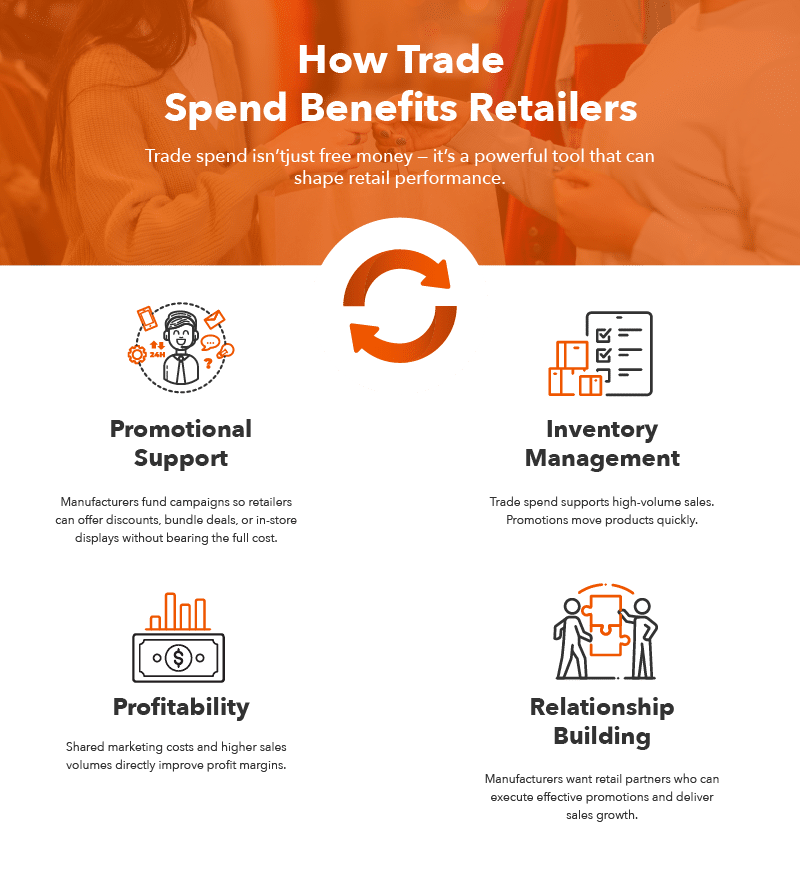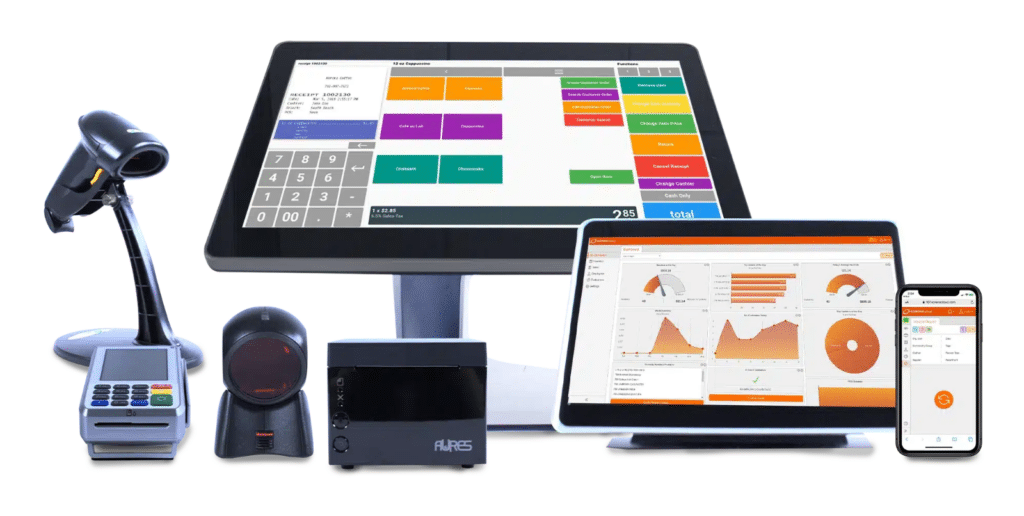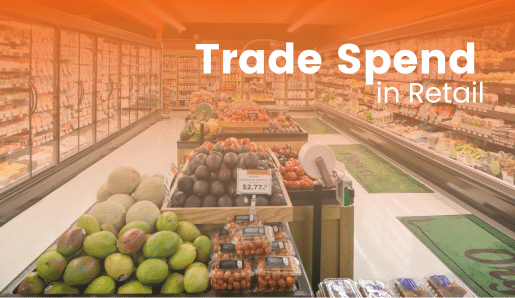Trade spend is one of the biggest drivers of retail growth, but it’s often misunderstood. Simply put, trade spend is the money manufacturers invest in helping retailers sell more.
This article explains what trade spend is, why it matters, its common forms, and how to manage it effectively. Along the way, we’ll show how KORONA POS helps retailers track ROI and maximize every dollar of trade spend.
Key Takeaways:
- Trade spend is how manufacturers fund discounts, promotions, and retailer support to sell more products.
- Retailers benefit through marketing support, inventory turnover, and higher profitability.
- A smart POS system like KORONA POS makes managing, tracking, and maximizing trade spend seamless.
What is Trade Spend?
Trade spend is the financial investment manufacturers make to push their products in retail stores. It covers promotions, discounts, advertising support, and co-marketing campaigns.
Without trade spend, many new products would never make it onto shelves — or into carts.
Why do Manufacturers Invest in Trade Spend?
Trade spend is one of the largest line items in consumer goods budgets. Here’s why it matters so much:
Consumer Awareness
New products don’t sell if nobody notices them. Trade spend funds displays, endcaps, and signage that put products in customers’ paths. Often, this includes investing in retail store equipment for displays — from shelving and racks to branded fixtures — all designed to grab attention and drive sales.
Sales Boost
Discounts and bundles push shoppers to act fast. These short-term spikes help brands hit volume goals and clear stock.
Strategic Partnerships
Retailers rely on manufacturer support to fund promotions and reduce risk. Manufacturers who invest wisely build long-term loyalty with their retail partners.
PRO TIP!
Use POS data to test which placements actually drive sales, and POS reporting to share transparent results with suppliers.
Common Types of Trade Spend
Trade spend shows up in different forms. The most common types of trade spend include:
Promotional Allowances
Manufacturers reimburse retailers for discounts or buy-one-get-one deals. This keeps products affordable for shoppers without hurting retailer margins.
Another form is swell allowance, which compensates retailers for unsold or damaged goods. This ensures stores don’t take a financial hit when products can’t be sold, while also encouraging them to keep stocking new items.
Slotting Fees
Brands pay retailers to secure shelf placement, particularly in premium locations such as eye-level shelves or end caps. Better placement = higher visibility and more sales.
Cooperative Marketing
Retailers and manufacturers split costs for ads, flyers, or online promotions. Both benefit from greater reach and stronger branding.
Trade Spending Strategy
The smartest trade spend strategies balance short-term promotions with long-term brand building. Manufacturers must target promotions around consumer demand, while retailers need to ensure campaigns move inventory without over-discounting.
PRO TIP!
Sync promotions with seasonality and local demand, then track performance with your POS to refine strategy over time.

How Trade Spend Benefits Retailers
Trade spend isn’t just free money — it’s a powerful tool that can shape retail performance. When used strategically, it helps retailers move inventory faster, improve profit margins, and strengthen relationships with suppliers.
Promotional Support
Manufacturers fund campaigns so retailers can offer discounts, bundle deals, or in-store displays without bearing the full cost. These campaigns attract more shoppers and create excitement around specific brands. For smaller retailers, that support can close the gap with larger competitors and increase market visibility.
Inventory Management
Trade spend supports high-volume sales. Promotions move products quickly. This rapid movement is vital for seasonal or perishable items. Retailers prevent financial loss from waste. They also avoid deep markdowns later. They clear old stock fast. This frees up valuable shelf space. Retailers make room for fresh, more profitable inventory. Trade spend keeps the entire merchandise cycle efficient.
Profitability
Shared marketing costs and higher sales volumes directly improve profit margins. Retailers can utilize trade spend to increase store traffic and boost basket size with minimal financial risk. The result is more revenue from both promotional and regular-priced items.
Relationship Building
Manufacturers want retail partners who can execute effective promotions and deliver sales growth. When retailers manage trade spend effectively, they demonstrate reliability and performance. That often leads to better pricing, early access to products, and increased cooperative funding for future campaigns.
Inventory management a headache?
KORONA POS makes stock control easy. Automate tasks, generate custom reports, and learn how you can start improving your business.
Example of Trade Spend in Retail
Here’s what trade spend looks like in real-world retail settings:
Promotional Campaign
A soda brand funds a summer campaign with discounts, branded coolers, and in-store signage. Customers notice — and sales spike.
Financial Support
A snack company covers 50% of the cost for an endcap display. The retailer gets prime visibility without a major financial hit (see swell allowance in retail).
Tracking Sales Performance
KORONA POS tracks SKUs before, during, and after the campaign. Retailers see if promos worked or fell flat — no guesswork required.
Reaping the Benefits
Retailers get higher sales and free marketing, while manufacturers lock in customer loyalty (see retail store equipment for displays).
Challenges in Trade Spend Management
Trade spend pays off — if you can manage it well. Here are the common hurdles:
ROI Measurement
Many promotions appear attractive on paper but fail to drive profit. POS analytics give hard numbers to show real performance.
Discover Advanced Analytics and Custom Reports
Speak with a product specialist and learn how KORONA POS can work for your business.
Promotion Clutter and Cannibalization
Too many promos confuse shoppers and sometimes shift sales away from other products. Careful scheduling avoids cannibalization.
Compliance Issues
Promotions come with terms. If rules aren’t followed, it strains the relationships between manufacturers and retailers. POS systems track agreements and reduce disputes.
How POS Systems Support Trade Spend Management?
Trade spend—the investments retailers make in promotions, co-op marketing, and discounts—is critical for driving sales but notoriously hard to manage. Advanced Point-of-Sale (POS) systems are essential tools that transform this complex accounting challenge into a strategic advantage by tracking every transaction detail in real-time.
Efficient Inventory Management
POS systems automatically update inventory levels and correlate stock movements with promotional activity. This helps retailers align inventory with demand, reduce excess stock, and avoid costly shortages during active campaigns.
Monitoring Promotional Performance
Detailed sales and discount tracking enable retailers to assess the effectiveness of each promotion. They can compare results across different stores or timeframes to identify which campaigns drive real ROI and which need adjustments.
Analyzing Buying Behavior
POS data provides valuable insights into customer preferences, purchase frequency, and responsiveness to promotional offers. Retailers can use these insights to design more targeted offers and refine trade spend allocation.
Optimizing Vendor Collaboration
By sharing POS-generated sales data with suppliers, retailers can negotiate better trade terms, plan co-funded promotions more strategically, and ensure vendor incentives are tied to measurable performance.
Enhancing Forecast Accuracy
With comprehensive sales trend analysis, POS systems help retailers forecast future demand more precisely, improving budgeting decisions and reducing wasted trade spend.
Ensuring Compliance and Transparency
POS systems record every transaction and promotion, ensuring clear visibility into how trade funds are used. This supports audit compliance and builds trust across vendor partnerships.
With KORONA POS, retailers can:
- Track promotions in real-time to measure sales lifts.
- Automate ROI reporting to share with suppliers.
- Spot trends to prevent cannibalization and over-discounting.
- Use data to negotiate better manufacturer partnerships.
Speak with a product specialist and learn how KORONA POS can power your business.
Maximize Your Trade Spend with KORONA’s Smarter Retail Solution

Trade spend is one of the most powerful tools in retail. When managed well, it drives awareness, boosts sales, and strengthens partnerships.
With KORONA POS, retailers can maximize every dollar of trade spend through data-driven insights and automated reporting.
Get started with KORONA POS today!
Explore all the features that KORONA POS has to offer with an unlimited trial. There’s no commitment or credit card required.
FAQs
What does trade spend mean in retail?
It’s the money manufacturers invest in discounts, promotions, and retailer support to boost sales.
How does trade spend benefit retailers?
It funds promotions, reduces costs, improves margins, and strengthens supplier relationships.
How can retailers manage trade spend effectively?
With tools like KORONA POS, which track promotions, monitor ROI, and provide negotiation-ready data.












